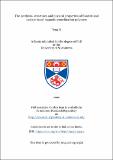Files in this item
The synthesis, structures and physical properties of fluoride and oxalate based magnetic coordination polymers
Item metadata
| dc.contributor.advisor | Lightfoot, Philip | |
| dc.contributor.author | Li, Teng | |
| dc.coverage.spatial | xiii, 214 p. | en_US |
| dc.date.accessioned | 2021-11-11T11:50:18Z | |
| dc.date.available | 2021-11-11T11:50:18Z | |
| dc.date.issued | 2020-06-30 | |
| dc.identifier.uri | https://hdl.handle.net/10023/24312 | |
| dc.description.abstract | en_US | |
| dc.description.abstract | This thesis describes the crystal structures and physical properties of three types of organic-inorganic hybrid coordination polymers (CPs): organic-inorganic hybrid fluoride layered perovskites, oxalate fluoride CPs and metal(III)-fluoride compounds. Most of the compounds presented here were synthesised through hydrothermal and solvothermal reactions, except two metal(III)-fluoride compounds which were synthesised by a layered solution method. For the organic-inorganic hybrid layered perovskites, seven compounds are reported. The crystal structures are revealed by single crystal X-ray diffraction. The magnetic properties of some have also been characterised by SQUID magnetometry, and the results show the metal centres in all the compounds display antiferromagnetic interactions at high temperature. For the compounds (enH₂)MnF₄ (1) and (enH₂)CoF₄ (2), variable temperature crystal structure analysis has been carried by the powder synchrotron X-ray diffraction and powder neutron diffraction. The results of Rietveld refinements show no phase transition was observed for both compounds. The magnetic structure of 2 has also been determined from the neutron data, in which the interactions of Co remain antiferromagnetic, with the magnetic moment (Mx0, My0, Mz0) = (3.53, 0, 0.53) at 20 K. In addition, the crystal structures of two derived compounds are also presented in this section. For the oxalate fluoride compounds, nine crystal structures are also characterised by single crystal X-ray diffraction. The compounds are in the form of 1D or 2D magnetic structures which are constructed by the metal centres and versatile coordination modes of the oxalate ligands. Magnetic characterisations show nearly all the compounds display antiferromagnetic interactions at high temperature, which are all well fitted by the 1D Heisenberg model. The majority of the seven metal(III)-fluoride compounds contain monomeric units. However, two unusual layered structures, which may form part of a homologous series, have been discovered, and there are some relationships between the syntheses and structures which can be applied in more targeted work in the future. | en_US |
| dc.description.sponsorship | "I thank CSC, the University of St Andrews and RSC for the funding." -- Acknowledgements | en |
| dc.language.iso | en | en_US |
| dc.publisher | University of St Andrews | |
| dc.relation | Data underpinning Teng Li's thesis. Li, T., University of St Andrews. DOI: https://doi.org/10.17630/7b407211-b4f9-45f8-a8ae-b15af3ef049d | en |
| dc.relation.uri | https://doi.org/10.17630/7b407211-b4f9-45f8-a8ae-b15af3ef049d | |
| dc.subject.lcc | QD382.C67L5 | |
| dc.title | The synthesis, structures and physical properties of fluoride and oxalate based magnetic coordination polymers | en_US |
| dc.type | Thesis | en_US |
| dc.contributor.sponsor | China Scholarship Council (CSC) | en_US |
| dc.contributor.sponsor | University of St Andrews | en_US |
| dc.contributor.sponsor | Royal Society of Chemistry (Great Britain) | en_US |
| dc.type.qualificationlevel | Doctoral | en_US |
| dc.type.qualificationname | PhD Doctor of Philosophy | en_US |
| dc.publisher.institution | The University of St Andrews | en_US |
| dc.rights.embargodate | Embargo period has ended, thesis made available in accordance with University regulations | en |
| dc.identifier.doi | https://doi.org/10.17630/10023-24312 |
This item appears in the following Collection(s)
Items in the St Andrews Research Repository are protected by copyright, with all rights reserved, unless otherwise indicated.

